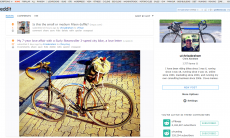A Hunch Blog post from last week (“You’ve got mail: What your email domain says about you”) made some noise around the net, courtesy of Gizmodo, swissmiss, and hundreds of tweets and retweets, most likely by Gmail users, who are depicted very favorably compared to Yahoo!, Hotmail and poor AOL users. But how much of that is really “utterly fascinating psychographic analysis” – as described by some of the retweeters – and how much is just over-extending the concept of marketing segmentation? Is the average Gmail user significantly different from the average Yahoo! user?

Image by enriqueburgosgarcia via Flickr
This is how that post summarized its findings:
- AOL users are most likely to be overweight women ages 35-64 who have a high school diploma and are spiritual, but not religious. They tend to be politically middle of the road, in a relationship of 10+ years, and have children. AOL users live in the suburbs and haven’t traveled outside their own country. Family is their first priority. AOL users mostly read magazines, have a desktop computer, listen to the radio, and watch TV on 1-3 DVRs in their home. At home, they lounge around in sweats. AOL users are optimistic extroverts who prefer sweet snacks and like working on a team.
- Gmail users are most likely to be thin young men ages 18-34 who are college-educated and not religious. Like other young Hunch users, they tend to be politically liberal, single (and ready to mingle), and childless. Gmail users live in cities and have traveled to five or more countries. They’re career-focused and plugged in — they mostly read blogs, have an iPhone and laptop, and listen to music via MP3s and computers (but they don’t have a DVR). At home, they lounge around in a t-shirt and jeans. Gmail users prefer salty snacks and are introverted and entrepreneurial. They are optimistic or pessimistic, depending on the situation.
- Hotmail users are most likely to be young women of average build ages 18-34 (and younger) who have a high school diploma and are not religious. They tend to be politically middle of the road, single, and childless. Hotmail users live in the suburbs, perhaps still with their parents, and have traveled to up to five countries. They mostly read magazines and contemporary fiction, have a laptop, and listen to music via MP3s and computers (but they don’t have a DVR). At home, Hotmail users lounge around in a t-shirt and jeans. They’re introverts who prefer sweet snacks and like working on a team. They consider themselves more pessimistic, but sometimes it depends on the situation.
- Yahoo! users are most likely to be overweight women ages 18-49 who have a high school diploma and are spiritual, but not religious. They tend to be politically middle of the road, in a relationship of 1-5 years, and have children. Yahoo! users live in the suburbs or in rural areas and haven’t traveled outside their own country. Family is their first priority. They mostly read magazines, are almost equally likely to have a laptop or desktop computer, listen to the radio and cds, and watch TV on 1-2 DVRs in their home. At home, Yahoo! users lounge around in pajamas. They’re extroverts who prefer sweet snacks and like working on a team. Yahoo! users are optimistic or pessimistic, depending on the situation.
I’m primarily a Gmail user, and definitely not a young man under 34, not single, not thin. Maybe I’m the exception that confirms the rule, but looking at how the data was collected and how it’s analyzed, you start wondering about what they mean by “margin of error is +/- 1%”. First of all, the sample is composed of Hunchers (people who bothered to answer their 20 questions to build a taste profile). The majority of respondents use Gmail, and Yahoo! is not even the second largest contingent. Contrast that with other data showing that Yahoo! Mail may have three times more visits that Gmail, even though that advantage seems to be shrinking.
Of course, this is nothing new. A year ago, as the Hunch post acknowledges, the Oatmeal has done a similar, tongue-in-cheek, analogy (please do visit their site for a more readable image):

Similar to the Mac guy vs. the PC guy, and all the generational stereotyping, these shallow interpretations of market segmentation carry some degree of prejudice behind their light-hearted approach. Of course, there’s no such a thing as the average person, which would be Asian, Christian, a Mandarin speaker, with no access to computers or the Internet and no University degree. Most of us would not fit that profile.
That’s not to say that market segmentation is not a useful tool, but a bare minimum quality to it is needed. The text book example of inappropriate use of that tool is to divide table salt buyers into blond and brunette customers and mistake the differences between those two groups as indicators of purchasing behavior. Useful market segments need to be measurable, substantial, accessible, differentiable and actionable (Kotler et al.).
Of course, there is probably some merit in the domain comparisons with regard to AOL users. Because AOL was extremely popular as an Internet service provider in the 1990s and almost insignificant now, it does serve as a marker of a given segment of the population who remained loyal to it. Other than that, most of the attributes linked to the other major mail domains are likely to not be substantial, differentiable and actionable. Discarding Yahoo! Mail and Hotmail users as not being computer savvy or career-focused or “plugged-in” may be a major mistake in one’s online marketing strategy.




